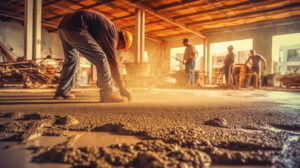A home’s foundation can suffer many issues, resulting in cracked walls and uneven floors. Other signs include nails pulling out of drywall and gaps in doorframes.

Often, vertical cracks are early warning signs and can be easily patched with epoxy. However, horizontal cracks are more serious and indicate that your foundation is shifting. For professional help, contact Sugar Land Foundation Repair now!
Foundation cracks can happen for a variety of reasons. In many cases they’re harmless and even expected. However, there are times when the cracks will signal a larger problem and need to be repaired. If you notice a crack in your home, it’s important to check with a professional to see if the crack is structurally significant and needs repairing.
The first thing to determine is whether the crack is static or moving. Static cracks are those that appeared when the house settled slightly and have not moved very much since. Moving cracks indicate that the foundation is sinking or shifting and can continue to do so.
If you have a crack in your foundation wall that moves in a vertical or diagonal direction, it’s likely due to movement in the soil and needs repairing immediately. It’s also an indicator that the ground is compressing under your foundation. These cracks are best treated with wall plate anchors. These are placed on the inside and outside of your foundation walls with a high-strength rod that ties them together.
A horizontal crack in the middle of the foundation may indicate a serious issue and should be immediately repaired. These types of cracks typically mean that the foundation is under extreme pressure and if left untreated can lead to wall bowing, tiling issues and other problems. This type of crack needs to be inspected by a professional foundation repair specialist and possibly require some level of stabilization such as soil injection or helical anchors.
Finally, cracks in the bottom of the basement floor are generally a sign of leakage and should be repaired as soon as possible. They can be caused by several factors such as poor construction, soil that swells or shrinks when wet, lack of drainage, earthquakes and temperature changes. If the crack is accompanied by a slight bulge it’s very important to consult a professional foundation contractor immediately to ensure it doesn’t lead to further damage and potential flooding.
If the crack is only 1/8 inch or less in width it’s usually not a structural problem and can be fixed with concrete crack filler. However, it’s a good idea to have this and other non-structural cracks inspected by a professional to ensure that they don’t worsen. It’s also a good idea to ensure that the crack is properly sealed to keep out moisture, soil smells and radon gas.
Structural Issues
Sometimes the most serious home foundation issues are not easy to spot. Hairline cracks, uneven gaps between windows and doors, and other small everyday problems can actually be the first signs of serious structural issues if left untreated.
Those little cracks in the walls can give rise to bigger problems like leaks and even a sinking house. It is crucial to catch these issues early on, before they spiral out of control. This will not only save you money on repairs, but it may also allow you to sell your home faster if you decide to move on in the future.
Structural issues are more common in older homes, due to improper home maintenance and past owners who cut trusses, but they can happen to new construction as well. If not addressed right away, these issues will get worse over time and can lead to sagging floors, wall cracks, jammed windows and doors, and other expensive problems that can make your home unsafe for you and your family.
The way a home feels and looks is a direct reflection of how its foundation is doing. If a house feels spongy or uneven, it is probably due to soil movement and settling, a sign of major foundation issues. You should always check the condition of a house’s foundation and its surrounding landscaping to ensure they are in good shape.
If you see water pooling or stagnating around the foundation of a house, this is another big sign that there are issues with the home’s structure. The most common reason for this is poor drainage, which allows rainwater to soak into the foundation and cause damage. Foundation engineers can install drains and other solutions to address this issue.
If you notice that a home’s foundation is eroding or shifting, it is important to have a professional evaluate the situation and make recommendations for repair. If the issue is serious, foundation jacking or underpinning may be necessary. Depending on the severity of the problem, these methods can be quite costly. To help mitigate the cost, you can ask the seller to pay for a home inspection and for the costs of any recommended foundation repair before you purchase the property.
Underpinning
A house, building or other structure can experience issues that require underpinning. In general, this involves lowering the existing foundation to increase depth and distribute the load more widely. It’s often done during home additions and renovations. It can also happen naturally as soils shift underneath a structure.
The primary issue is moisture, which can cause shifting and expansion or shrinkage of soils beneath a foundation. The resulting imbalance can make the foundation crack or sink. This issue can be made worse by clay soils, which absorb water and change volume more easily than loamy or sandy soils. This problem can be minimized by installing a gutter system, grading soil away from the foundation and considering a foundation drainage system.
Earthquakes can also shift soils, leaving portions of the foundation without adequate support. This isn’t usually a huge problem, but it can lead to damage that requires underpinning.
Poor construction can also lead to underpinning issues. This could be a result of contractors using inadequate materials or building on poorly-draining soils. It can also be caused by adding a story to a home, which adds significant weight to the foundation.
Other signs that you might need underpinning include gaps appearing and getting wider around windows and doors, difficulty opening or closing doors and a noticeable leaning of the house. These are all indications that you need to contact a foundation repair company in your area for an inspection and underpinning estimate.
There are several underpinning solutions available, including push piers, which are driven into the ground until they reach the load-bearing strata. Helical piers are screwed into the ground and are ideal for structures with light loads. They’re commonly used where a concrete underpinning isn’t possible. Screw piles work in a similar way but are designed for use in foundations with particular qualities and are paired with underpinning support brackets. This method is also suitable for applications where excavation isn’t practical. For example, when a foundation needs to be underpinned on unstable land or in areas where access is limited. This is also known as the “jacking” technique.
Slabjacking
Slabjacking is a method of raising a sinking foundation slab, especially in homes built on concrete slabs. A mixture of mud and concrete is pumped under the foundation to fill the void and raise it back up. The contractor uses a drill to make holes in the concrete in a pattern that will lift the slab. This is not a permanent solution, but will give you time to find more extensive repair methods.
Sinking concrete often results from erosion and poorly compacted soil. It may also be a sign of more serious structural issues with your home that require professional repairs. The closer the sinking concrete is to your house, the more likely it is to cause other problems as well. For example, a sloping concrete slab can direct water towards your foundation and cause other areas of your home to sag. This can lead to leaks and even flooding of your basement or crawl space.
Mudjacking can be a good option for raising the interior floors of your foundation, as it is less expensive than other types of repair. However, it is not a permanent fix and will not protect your foundation from further damage. A more permanent option is to use steel piers instead. These are small concrete piers that are driven into the ground to support your foundation. Steel piers are not as costly as concrete pressed pilings and are easier to install, since they don’t require significant excavation.
Another option for raising the interior of your foundation is foam injections. This method is ideal for stabilizing stairs that are sinking due to soil erosion. It can save you thousands in future costs and prevents the need for staircase replacement.
Helical piers are also an excellent choice for supporting your foundation when soil conditions aren’t ideal for other repair methods. These piers are made of steel and have spiral-shaped heads that screw into the ground. They are a more environmentally friendly option than concrete piers, as they do not require significant excavation. They are also faster to install, making them an excellent choice for homeowners who need immediate support for their foundations.
